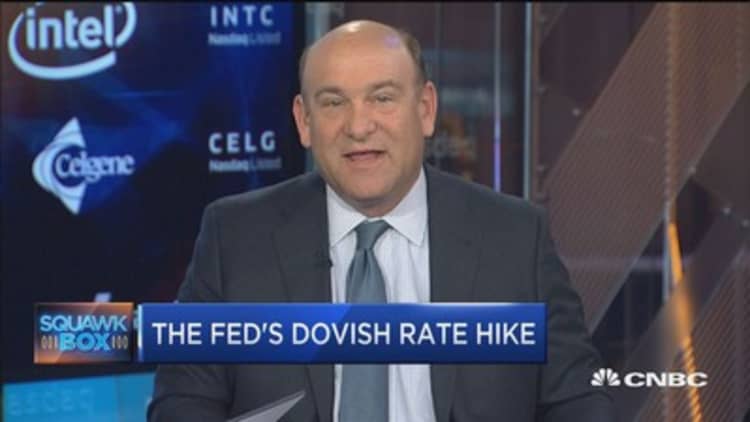
When the Fed voted to hike interest rates, the market reaction saw stocks rise, bond yields fall and the U.S. dollar decline against its global peers. That, according to Goldman Sachs, was pretty much precisely the wrong reaction.
After all, the U.S. central bank, by increasing its benchmark rate, was trying to tighten up things at least a little.
Instead, a measure Goldman uses to gauge financial conditions actually loosened afterward. The upshot: Investors may be underestimating how quickly the Fed will move in the future.
"We feel quite confident that they were not aiming for a large easing in financial conditions," Jan Hatzius, Goldman's chief U.S. economist, said in a note to clients. "After all, the primary point of hiking rates is to tighten financial conditions, perhaps not suddenly but at least gradually over time."
Fed officials did reiterate that they are keeping a gradualist approach to policy, with no preset course on the way back to a normalization of rates. Consequently, the term "dovish hike" gained popularity as the Federal Open Market Committee's decision, and accompanying language and economic projections, appeared not as aggressive as some market participants had feared.
Still, the reaction seemed outsized across financial markets at a time when monetary policy will be getting more restrictive, not less.
Goldman's proprietary financial conditions index showed a 0.14 percentage point easing after the FOMC decision came out at 2 p.m. Wednesday. For perspective, Hatzius said that kind of move would be the historical equivalent of a quarter-point cut in the funds rate rather than an increase.
Here's a visual for how Goldman's FCI has moved over the last nine months or so:
The direction of financial conditions is no small matter for the Fed. The measures basically take into account government debt yields and spreads in bond rates, along with stock market prices and moves in currencies, measured against economic growth projections. The Chicago Fed has its own FCI but it has not been updated since Wednesday's decision.
Yellen is watching
Though she didn't mention any firms by name, Fed Chair Janet Yellen, during her post-FOMC meeting news conference Wednesday, did refer to "private sector analysts that produce financial conditions indices." Yellen's comments indicated that Fed decision-making is influenced by those measures.
If the rate moves actually have the net effect of loosening conditions, that could push the Fed's hand to get tougher.
"At the margin, (Wednesday's) FCI move has increased our conviction that the committee will need to deliver more tightening than priced in the markets at this point," Hatzius said.
Hatzius isn't the only economist on Wall Street who thinks the market misinterpreted the Fed's indications.
Tom Porcelli, chief U.S. economist at RBC Capital Markets, said the market misread the Fed's closely watched "dot plot" of individual members' expectations for rates in the future.
While the median level did not change, the composition shifted to where there are now just three members not expecting at least three hikes this year as opposed to six when Fed officials last submitted projections in December.
"While the median did not move, the shift in the distribution is still without question hawkish," Porcelli said in a note.
Market reaction was somewhat less buoyant Thursday. Major stock market averages were in the red in late-morning trade while Treasury yields edged higher.
Traders are assigning only a 4 percent chance of a rate hike at the May meeting but a 57 percent for June and a 58 percent chance that the third move of the year will come in December, according to the CME.


